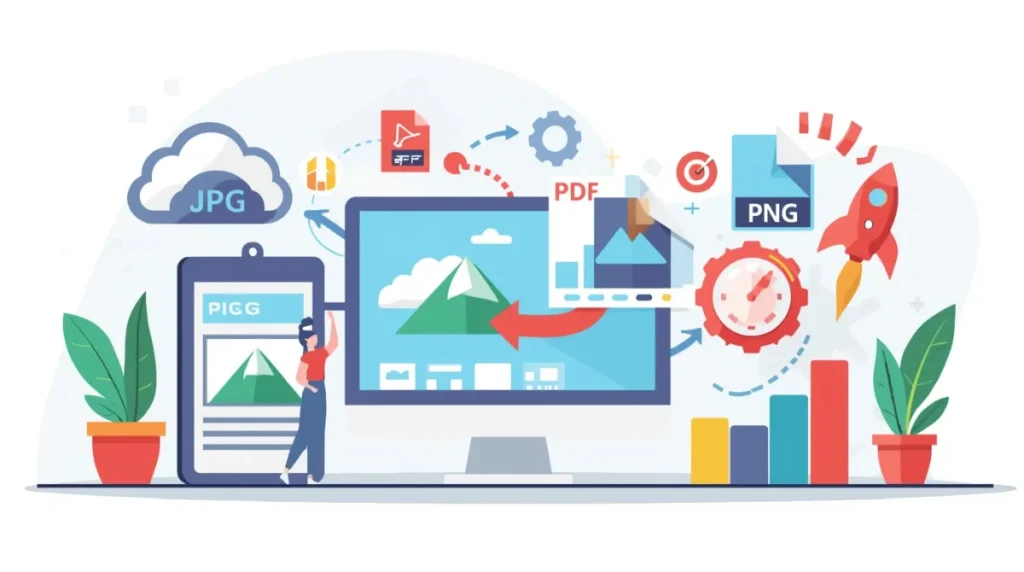Top 10 Image Conversion Tools for Fast, Easy for Better Optimization and Fast Results
In the digital world, image quality and optimization play a critical role in website speed, SEO performance, and user engagement. Choosing the right tools can make the difference between slow-loading websites and lightning-fast pages that attract visitors. In this detailed guide, we’ll explore the Top 10 Image Conversion Tools for Fast, Easy & SEO-Friendly File Optimization, highlighting their features, benefits, and how they can improve both user experience and search rankings.
Whether you’re a blogger, digital marketer, or website owner, these tools can help you resize, compress, and convert images without losing quality while ensuring SEO best practices.
Why Image Optimization Matters for SEO
Before diving into the Top 10 Image Conversion Tools for Fast, Easy & SEO-Friendly File Optimization, it’s important to understand why image optimization matters:
- Website Speed: Optimized images reduce file size, improving loading times.
- Search Engine Ranking: Google considers page speed as a ranking factor.
- User Engagement: High-quality, fast-loading images keep visitors on your site longer.
- Google Discover & Image Search Visibility: Properly formatted and optimized images increase the chances of being featured in Google Discover and image search results.
- Mobile Experience: Optimized images enhance mobile performance, which is crucial since most traffic now comes from smartphones.
👉 For more details, you can check Google’s image optimization guidelines.
The Top 10 Image Conversion Tools for Fast, Easy & SEO-Friendly File Optimization

Now, let’s dive into the best image conversion and optimization tools that can transform how you manage media on your website.
1. Image Resizer
The Image Resizer is perfect for adjusting image dimensions without losing clarity. If your site relies on high-resolution visuals, resizing them to exact dimensions helps balance quality and speed.
Features:
- Resize images in bulk.
- Maintain aspect ratio for responsive design.
- Custom pixel and percentage scaling.
Best Use Case: Optimizing product images for eCommerce websites.
2. Image Size Increaser
Sometimes, you need larger images without pixelation. The Image Size Increaser tool uses AI-powered algorithms to upscale images while maintaining sharpness.
Features:
- AI-based upscaling.
- Increases resolution without blurriness.
- Supports multiple formats.
Best Use Case: Designers and photographers who want to enhance old or low-resolution images.
3. WebP to PNG Converter
Google recommends WebP format for faster performance, but some platforms still require PNG. That’s where the WebP to PNG Converter comes in handy.
Features:
- Converts WebP files into lossless PNG images.
- Retains transparency and quality.
- Batch conversion support.
Best Use Case: Bloggers and developers working with cross-platform image requirements.
4. Image to WebP Converter
The Image to WebP Converter is a must-have for SEO-friendly websites. WebP format reduces file size while keeping quality intact.
Features:
- Converts JPG, PNG, and GIF to WebP.
- Reduces size by up to 50%.
- Supports both lossy and lossless compression.
Best Use Case: Webmasters who want better Core Web Vitals scores.
5. JPG to PNG Image Converter
The JPG to PNG Image Converter makes it easy to switch from JPG to PNG for cases requiring higher quality and transparency.
Features:
- Maintains transparency.
- Simple drag-and-drop conversion.
- Retains image metadata.
Best Use Case: Businesses creating transparent logos and graphics.
6. Image Size Reducer
If you want faster website load times, the Image Size Reducer is essential. It compresses images without noticeable loss in quality.
Features:
- Advanced compression algorithms.
- Supports JPG, PNG, and GIF.
- Optimized for SEO-friendly file sizes.
Best Use Case: Bloggers and website owners optimizing for mobile speed.
7. Google Discover Image Optimization
The Google Discover Image Optimization tool ensures your images are formatted according to Google’s Discover requirements. Since Google Discover is a major traffic source, this tool is crucial for SEO.
Features:
- Ensures image width is at least 1200px.
- Adds structured data for visibility.
- Optimizes images for Google Discover feeds.
Best Use Case: Publishers and content creators targeting higher traffic from Google Discover.
8. JPEG to JPG Converter
The JPEG to JPG Converter may sound redundant, but some systems distinguish between file extensions. This tool standardizes your image library.
Features:
- Converts JPEG to JPG seamlessly.
- Batch file conversion.
- Maintains original quality.
Best Use Case: Simplifying image naming for consistency across platforms.
9. PDF to JPG Converter
The PDF to JPG Converter is helpful when you need to extract images from PDF files for digital publishing or SEO use.
Features:
- Converts each page into a high-resolution JPG.
- Preserves formatting.
- Batch conversion available.
Best Use Case: Businesses digitizing reports and marketing materials.
10. Word to PDF Converter
The Word to PDF Converter is not just for documents but also for image-heavy content. Converting to PDF ensures a professional, shareable format.
Features:
- Converts Word files into PDFs with embedded images.
- Retains layouts and fonts.
- Compatible with SEO-friendly file naming.
Best Use Case: Content creators and businesses creating downloadable guides.
11. JPG to PDF Converter
The JPG to PDF Converter allows users to bundle multiple images into one PDF file. This is useful for portfolios, presentations, and marketing content.
Features:
- Supports multiple JPG files in a single PDF.
- Maintains high resolution.
- Easy-to-share document format.
Best Use Case: Designers, photographers, and educators.
12. PNG to WebP Converter
Finally, the PNG to WebP Converter is essential for modern web optimization. Converting PNG files to WebP drastically reduces file size while retaining transparency.
Features:
- Converts transparent PNG to WebP.
- Reduces image size by 30–70%.
- Boosts SEO performance with faster loading speeds.
Best Use Case: Websites aiming to improve Core Web Vitals and mobile SEO.
How These Tools Improve SEO

Using the Top 10 Image Conversion Tools for Fast, Easy & SEO-Friendly File Optimization ensures:
- Better Google Rankings through improved site speed.
- Higher Engagement with visually appealing, high-quality images.
- Increased Visibility in Google Discover and image search results.
- Cross-Platform Compatibility ensuring images display correctly everywhere.
For more SEO insights, explore Moz’s image SEO guide.
Perfect ✅
FAQs
Top 10 Image Conversion Tools for Fast, Easy & SEO-Friendly File Optimization
To help you get the most out of these tools, here are answers to some of the most commonly asked questions.
1. What is the best free image converter for SEO?
The best free image converter for SEO depends on your needs:
- For speed optimization, the Image to WebP Converter is highly recommended.
- For transparency and logos, the JPG to PNG Image Converter works best.
- For bulk image optimization, the Image Size Reducer is effective.
👉 If you’re looking for all-in-one SEO-friendly solutions, consider pairing these converters with free tools like TinyPNG or Squoosh for extra compression.
2. How do I optimize images for Google Discover?
To optimize images for Google Discover, you need to:
- Use images at least 1200 pixels wide.
- Implement structured data (Schema markup) for rich results.
- Compress images with the Google Discover Image Optimization tool to balance size and clarity.
- Save images in WebP format for faster loading.
This ensures your images meet Google’s technical and quality requirements.
3. Is WebP better than PNG and JPG for SEO?
Yes. WebP is better for SEO because it offers:
- Smaller file sizes (up to 70% smaller than PNG/JPG).
- Support for transparency and animation.
- Improved site speed, which boosts rankings.
Using tools like the PNG to WebP Converter or Image to WebP Converter ensures you get the SEO benefits of this modern format.
4. Can I convert images without losing quality?
Absolutely! The Image Resizer and Image Size Increaser tools allow you to adjust image size without losing sharpness. Similarly, the WebP to PNG Converter ensures quality is preserved during format conversion.
Pro Tip: Always test before publishing to confirm image clarity remains intact.
5. Why should I use a JPG to PDF Converter for SEO?
While images themselves don’t always need to be in PDF format, using the JPG to PDF Converter can improve:
- Content accessibility (easy to share/download).
- Professionalism (great for business reports).
- Indexing potential, as Google can index PDFs with text and images.
If your PDF is SEO-optimized with proper titles and metadata, it can rank in search results.
6. What are the most SEO-friendly image formats?
The most SEO-friendly image formats are:
- WebP – best for speed and compression.
- PNG – best for logos and transparency.
- JPG/JPEG – best for photographs with rich colors.
Each tool in the Top 10 Image Conversion Tools for Fast, Easy & SEO-Friendly File Optimization helps you switch between these formats depending on your needs.
7. How can I reduce image size for faster websites?
The Image Size Reducer is designed for this purpose. To make your website faster:
- Compress large images before uploading.
- Convert PNGs to WebP when possible.
- Use lazy loading to delay off-screen images.
👉 Bonus: Combine image compression with a Content Delivery Network (CDN) for even better performance.
8. Do I need different image formats for mobile and desktop SEO?
Not necessarily. With responsive design, one optimized format (like WebP) usually works across devices. However, it’s recommended to:
- Use the Image Resizer to create smaller versions for mobile.
- Use srcset attributes in HTML to serve different image sizes depending on device screen width.
This ensures optimal performance across desktop, tablet, and mobile devices.
9. Can I automate image conversion for SEO?
Yes! Many tools offer bulk processing and automation. For example:
- Image Size Reducer allows batch compression.
- PNG to WebP Converter can handle multiple images at once.
- Plugins like Smush or Imagify for WordPress automate optimization after upload.
Automation saves time and ensures consistent SEO-friendly image practices.
10. What is the difference between JPEG and JPG?
Technically, JPEG and JPG are the same format. The difference is simply in the file extension:
- .jpeg = used on older systems.
- .jpg = shortened version widely used today.
Using the JPEG to JPG Converter helps standardize file names across your site, preventing broken links or inconsistencies.
11. Which tool is best for bloggers and content creators?
For bloggers, the most useful tools from the Top 10 Image Conversion Tools for Fast, Easy & SEO-Friendly File Optimization are:
- Image Size Reducer (for faster blogs).
- Google Discover Image Optimization (for visibility).
- Image to WebP Converter (for SEO).
These tools improve user experience and help blogs rank higher in Google search.
12. Do optimized images really improve ranking on Google?
Yes! Optimized images impact Core Web Vitals, which Google uses as ranking signals. A site with faster loading images has a better chance of ranking higher.
Additionally, optimized images increase chances of appearing in Google Discover, Google Images, and featured snippets.
Conclusion:
Why You Should Use the Top 10 Image Conversion Tools for Fast, Easy & SEO-Friendly File Optimization
In today’s competitive digital landscape, image optimization is no longer optional—it’s essential. The Top 10 Image Conversion Tools for Fast, Easy & SEO-Friendly File Optimization provide everything from resizing and reducing file sizes to converting images into SEO-friendly formats like WebP and PDF.
By using these tools, you can:
- Improve your website speed.
- Boost Google rankings.
- Enhance mobile performance.
- Increase visibility in Google Discover and Images.
Incorporate these tools into your workflow, and you’ll not only create a visually stunning website but also an SEO powerhouse that drives organic traffic.
✅ Next Step: Start by testing your website speed on Google PageSpeed Insights and identify where image optimization can give you the biggest boost.
👉
Final Thoughts
The Top 10 Image Conversion Tools for Fast, Easy & SEO-Friendly File Optimization offer powerful features for businesses, bloggers, and marketers. From resizing and reducing file sizes to converting formats like WebP, PNG, JPG, and PDF, these tools are essential for fast-loading websites that rank higher on Google.
By using these image optimization solutions, you’ll improve user experience, meet SEO best practices, and drive more organic traffic to your site.
✅ Pro Tip: Combine these tools with a CDN (Content Delivery Network) like Cloudflare or ImageKit for even faster performance and SEO-friendly delivery.




